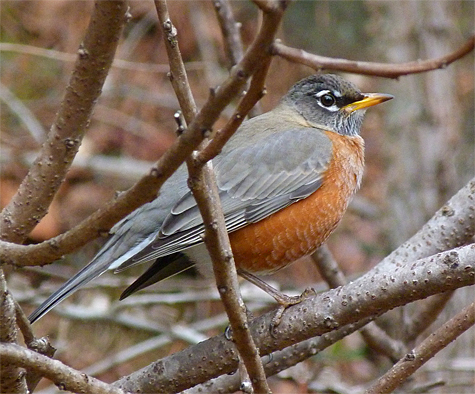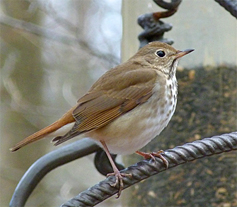
Everyone is familiar with the robin. It’s the bird that, when describing another bird, people often use as a reference, “it was about the size of a robin.” We see them on our lawns, in city parks, in our fruit trees, and even nesting in our backyards. We see them in every season of the year from the blistering heat of the summer to the frigid (especially this year) winter.
The American Robin got its name from the early European settlers who, upon seeing the bird for the first time thought it looked like a bird they were familiar with back in the motherland, the European Robin (Erithacus rubecula). The European Robin also has a reddish breast. However, the European Robin is not in the same family of birds as the American Robin.

A more fitting name for the American Robin might be Lawn Thrush. It is a thrush and most of us do encounter robins on lawns although I expect there were few if any lawns present when the early settlers arrived in North America. Their preferred habitat also includes deciduous woods, forest edges, and shrublands.
The robin’s latin, or scientific, name means migratory thrush. Robins do migrate, but so do the other thrushes. It’s the robin, though, that we see in large numbers feeding in crabapple trees, on golf course fairways, and lawns. Their movements north and south are much more obvious than their other thrush relatives and are easily observed by those of us who notice such things. Robins can be seen year round in just about every state in the lower forty-eight.
You’ve no doubt seen a robin wrestling with an earthworm trying to yank it out of the ground during the warm months but they also eat a variety of other invertebrates. In fall and winter they can easily, and I assume happily, switch over to fruit. I’ve more than once seen a flock of robins make a clean sweep of a hawthorn or other fruit laden tree or shrub.
Robins are tough, adaptable, and handsome birds. Most of us tend to not pay much attention to them, they’re commonplace. But try this, next time you see a robin, whether in the winter or during the warmer months, take the time to watch it for a brief while. I guarantee that you’ll discover something about the bird that you’ve never known or seen before, whether in the bird’s behavior or in its appearance.
Happy robin watching!
We call them “Brave Sir Robins” in my family. They often seem befitting of their Monty Python namesake: completely fearless until confronted with actual danger.
A long-time observation of mine is if you have a flock of Robins come into your yard stay on the lookout for they often bring in other bird species. I often say, “birds attract birds”, although I can’t recall ever reading that. Have you found that to be true, Greg? Also, I’ve found if you fill your birdbaths Robins will soon appear if they are anywhere in your area.
I’d have to agree with you about the water and your statement that “birds attract birds.” If a bird moving through the area spots other birds feeding they will most likely drop in to see what’s going on. If they like what they see, they’ll stay.
Water attracts birds, period. The birds will come in to both bathe in and drink your offering. Moving water brings them in even more. A trick we used while banding birds was to place a portable water drip near our nets to attract the migrating birds that were in the area. Birds zero in on the sound of the water and come in to drink and perhaps bathe.
Thanks, Judy.
I never knew a robin was a thrush. Thank you, Greg! I just read that robins can walk AND hop, one of the few birds that do both.
Yes indeed, it is a thrush, and so is the bluebird!
Glad you brought up the fact of the robin’s ability/tendency to both walk AND hop. Birds that spend all or most of their time foraging in trees and shrubs have evolved to hop instead of walk when moving along on the ground, warblers, kinglets, etc., they’ve lost the ability to walk. Those that spend most of their time on the ground tend to walk or run, a much more efficient way to get around than hopping. Try it yourself, you’d tire more quickly hopping than you would walking. Robins do both equally as well it seems. Robins spend much time on the ground, as you know, but they also spend a good bit of time foraging for fruit in trees.
Some birds, like crows walk, hop, skip and jump, so to speak, they do it all.
Thanks,